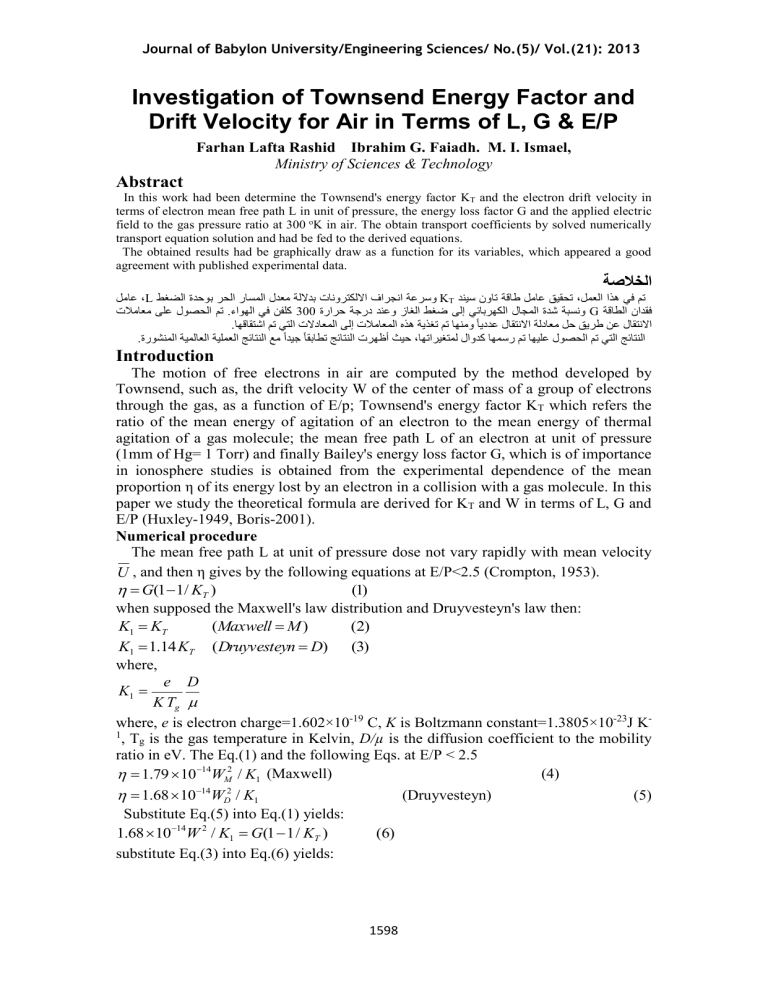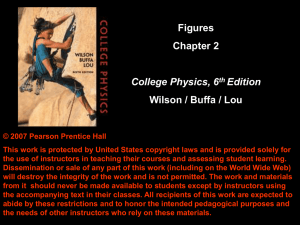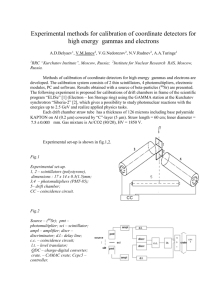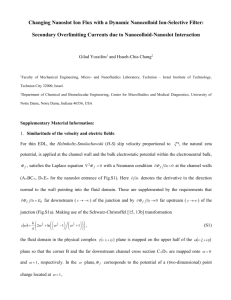Investigation of Townsend Energy Factor and Drift Velocity for Air in

Journal of Babylon University/Engineering Sciences/ No.(5)/ Vol.(21): 2013
Investigation of Townsend Energy Factor and
Drift Velocity for Air in Terms of L, G & E/P
Farhan Lafta Rashid Ibrahim G. Faiadh. M. I. Ismael,
Ministry of Sciences & Technology
Abstract
In this work had been determine the Townsend's energy factor K
T
and the electron drift velocity in terms of electron mean free path L in unit of pressure, the energy loss factor G and the applied electric field to the gas pressure ratio at 300 o K in air. The obtain transport coefficients by solved numerically transport equation solution and had be fed to the derived equations.
The obtained results had be graphically draw as a function for its variables, which appeared a good agreement with published experimental data.
ةصلاخلا
لماع ،
L
طغضلا ةدحوب رحلا راسملا لدعم ةللادب تانورتكللاا فارجنا ةعرسو
تلاماعم ىلع لوصحلا مت .ءاوهلا يف نفلك
.ةروشنملا ةيملاعلا ةيلمعلا جئاتنلا عم
300 ةرارح ةجرد دنعو زاغلا طغض
.اهقاقتشا مت يتلا تلاداعملا
ًاديج ًاقباطت
ىلإ تلاماعمل
جئاتنلا
K
T
دنيس ن وات ةقاط لماع قيقحت ،لمعلا
ترهظأ ثيح ،اهتاريغتم
ىلإ يئابرهكلا لاجملا ةدش ةبسنو
ل
اذه يف مت
G ةقاطلا نادقف
ا هذه ةيذغت مت اهنمو ًايددع لاقتنلاا ةلداعم لح قيرط نع لاقتنلاا
لاودك اهمسر مت اهيلع لوصحلا مت يتلا جئاتنلا
Introduction
The motion of free electrons in air are computed by the method developed by
Townsend, such as, the drift velocity W of the center of mass of a group of electrons through the gas, as a function of E/p; Townsend's energy factor K
T
which refers the ratio of the mean energy of agitation of an electron to the mean energy of thermal agitation of a gas molecule; the mean free path L of an electron at unit of pressure
(1mm of Hg= 1 Torr) and finally Bailey's energy loss factor G, which is of importance in ionosphere studies is obtained from the experimental dependence of the mean proportion η of its energy lost by an electron in a collision with a gas molecule. In this paper we study the theoretical formula are derived for K
T
and W in terms of L, G and
E/P (Huxley-1949, Boris-2001).
Numerical procedure
The mean free path L at unit of pressure dose not vary rapidly with mean velocity
U
, and then η gives by the following equations at E/P<2.5 (Crompton, 1953).
G ( 1
1 / K
T
) ( 1 ) when supposed the Maxwell's law distribution and Druyvesteyn's law then:
K
K
1
1
K
1 .
T
14 K
T
(
( Maxwell
Druyvestey
M n
)
D )
(
(
2
3 )
) where,
K
1
e D
K T g where, e is electron charge=1.602×10
-19
C, K is Boltzmann constant=1.3805×10
-23
J K
-
1 , T g
is the gas temperature in Kelvin, D/µ is the diffusion coefficient to the mobility ratio in eV. The Eq.(1) and the following Eqs. at E/P < 2.5
1 .
79
10
14
W
M
2
/ K
1
(Maxwell) (4)
1 .
68
10
14
W
D
2
/ K
1
(Druyvesteyn) (5)
Substitute Eq.(5) into Eq.(1) yields:
1 .
68
10
14
W
2
/ K
1
G ( 1
1 / K
T
) ( 6 ) substitute Eq.(3) into Eq.(6) yields:
1598
1 .
68
10
14
W
2
1 .
14 K
T
1 .
474
10
14
W
2
K
T
G ( K
T
G (
K
K
T
K
T
T
1 )
1 )
…………… …. (Druyvesteyn)
(7) substitute Eq.(4) into Eq.(1) yields:
1 .
79
10
14
W
2
/ K
1
G ( 1
1 / K
T
) ( 8 ) substitute Eq.(2) into Eq.(8) yields:
1 .
79
10
14
W
2
/ K
T
G ( K
T
1 ) / K
T
………. ….(Maxwell)
(9) but from the following equations we can find (Huxley,1949):
L
7 .
33
10
9
W
E
K
/ P
1
L
7 .
05
10
9
W
E
K
/ P
1
L
7 .
33
10
9
W 1 .
14 K
T
E / P
L
7 .
33
10
9
W
D
K
E / P
T substitute Eq.(2) into Eq.(11) yields:
( 10 )
( 11 ) substitute Eq.(3) into Eq.(10) yields:
(Druyvesteyn) (12)
L
7 .
05
10
9
W
M
K
E / P
T since
(Maxwell) (13)
W
M
W
D
E
0 .
851
H
0 .
9426
E
H tan
tan
(Maxwell)
(Druyvesteyn) where,
tan
1
e m
H m
H
E
V d
K
1
1
0 .
5
From Eqs.(7, 12) we can find:
W 2
1 .
G ( K
474
T
1 )
10
14
W
L ( E / P )
7 .
83
10
9
1
K
T
( 14 )
( 15 )
By square Eq.(15) and it's equal with Eq.(14) yield:
W
2
1 .
G ( K
474
T
1 )
10
14
7
L ( E
.
83
/ P )
10
9
2
1
K
T
……………..(Druyvesteyn)
(16)
Eq.(16) represents W in term of L, G and E/P. from Eqs.(9, 13) and squaring Eq.(13) and equal them, yield:
1599
Journal of Babylon University/Engineering Sciences/ No.(5)/ Vol.(21): 2013
W
2
G (
1 .
79
K
T
1 )
10
14
7 .
L ( E
05
/ P )
10
9
2
1
…………..(Maxwell)
K
T
Eq.(17) represents W in term L, G and E/P; where expressed in unit V/cm.
(17) from Eq.(16) obtained:
K
T
( K
T
1 )
1 .
474
10
7 .
83
14
10
L
2
9
( E
2
G
/ P )
2
K
T
( K
T
1 )
240
L
2
G
( E / P ) 2 i.e.
K
T
1
1
960
G ( E
L
2
/ P ) 2
1 2
Eq.(18)
2 represents from Eq.(16) also obtained:
W
W
( 18 )
…………………………….(Druyvesteyn)
(19)
K
T
L ( E / P )
7 .
83
10
19
1
K
T
1
1
1 .
27
10
8
960 L
2
( E
L ( E
/ P )
2
/
/
P )
G
0 .
5
1 2
2 in term L, G
………………….(Druyvesteyn) and
(20)
E/P.
Eq.(20) represents W in term L, G and E/P. from Eq.(17) obtained:
K
T
( K
T
1 )
1 .
79
10
7 .
14
05
( L
10
9
( E
2
/ P )
G
)
2
K
T
( K
T
K
T
( K
T
1 )
360
L
2
G
1 )
( E / P ) 2 ………………………. (Maxwell) (21)
1
1
1440
G ( E
L
2
/ P )
2
1 2
2
………..……….(Maxwell)
(22)
Eq.(21) represents K
T
in term L, G and E/P. from Eq.(17) also obtained:
W
W
L ( E
7 .
05
/ P
10
)
19
1
K
T
1 .
42
10 8 L ( E / P )
(23)
……………………….(Maxwell)
1
1
1440
L
2
( E / P )
2
2
G
1 2
1
2
(24)
Eq.(24) represents W in term L, G and E/P.
1600
From Eq.(1) when E/P<2.5 refers the
depends on K
T
with G=0.0013, for
Druyvesteyn's low. From the above at L=0.04, we substitute these values to the
Eqs.(19-20) respectively obtained as a special case, which:
K
T
1
1
1181 .
5 (
2
E / P )
2
1 2
…………… ……(Druyvesteyn) E/P<2.5
W
(25)
1
5
10
7
( E
1
1181 .
5 ( E
/ P )
/ P ) 2
1
2
1 2
2
…… ……..(Druyvesteyn) E/P<2.5
(26) at, 1181.5(E/P)
2
>>1
K
T
W
1 .
0 .
5
17 .
18
206
10
7
E
E
/
/
P
P (Druyvesteyn) (27)
(Druyvesteyn) (28)
Eqs.(25-28) were refer K
T
and W in term E/P for especial case from Eq.(18) yields: at: K
T
>>1,
K
T
15 .
4
G
L ( E / P ) (Druyvesteyn) (29) at: K
T
=1,
K
T
1
240 L
2
( E / P )
2
(Druyvesteyn) (30)
G
Eqs.(29-30) were represent K
T
in term L, G and E/P. from Eq. (21) yields: at K
T
>>1,
K
T
18 .
9
G
L ( E / P ) (Maxwell) (31) at: K
T
=1,
K
T
1
360 L
2
( E / P )
2
(Maxwell) (32)
G
Eqs.(31-32) were represent K
T
in term L, G and E/P.
Time – Dependent Electron Boltzmann Equation:
In this work could be used the final form taken by the time – dependent Boltzmann equation for electrons, as used in this paper, to obtain the transport coefficients, namely drift velocity, V d
, the ratio of the diffusion coefficient to the mobility, D /
and the momentum transfer collision frequency,
m
. Finally insert this parameters to our equations.
The standard procedure to study this problem starts with a Boltzmann equation usually written in the form (Guerra -2001,
2004 ميهاربا
F
t
r
( vF )
v
e E m
F
F
t
c
(33)
): since F ( r , v , t ) refers the electron velocity distribution function constrained to the normalization condition
F dv
n e
( r , t ), electron density respectively,
r
and
with dv and
v n e
are velocity space and the
are the gradient operators, e and m
( m
=9.109×10 -28
gm) are the electron absolute charge and mass, and the right – hand side of Eq.(33) refers a collision operator.
1601
Journal of Babylon University/Engineering Sciences/ No.(5)/ Vol.(21): 2013
Results and Discussion:
In this study had be investigate the Townsend's energy factor for air in term L, G &
E/P; this results appeared a good agreement with the reference (Huxley,1949).
Figs.(1-3) are showing the Townsend's energy factor K
T
versus the mean free path at unit of pressure, L, G and E/P. Fig(1) appeared the decreasing of K
T
with L increasing, i. e. the electrons losses it's energy through the L, but figs.(2, 3) appeared the K
T
increasing with G and E/P.
Fig.(4) appears the electron drift velocity was decreasing with L because the electrons could be its energy by the collisions through the mean free path L, but figs.(5, 6) the electron drift velocity could be increase with G and E/P because the electrons were gain the energy from the applied electric field.
Figs.(7-10) were represent the special case for E/P < 2.5 which is the Townsend's energy factor K
T and drift velocity W, as a functions of E/P< 2.5 for the special case, this figures were show the increasing of K
T
and W with E/P; for figs.(9, 10) the increasing was a ramp form for 1181.5(E/P)
2
>> 1.
Figs.(11-13) are referring the Townsend's energy factor as a function of: the mean free path, L, the energy loss factor, G and the applied electric field to the gas pressure ratio for Maxwell and Druyvesteyn distribution law for air, from fig.(11) at K
T
>>1 it's appeared decreasing the Townsend's energy factor with increasing of the mean free path L, because the electrons losses it's energy by the collisions, but for figs.(12, 13) at K
T
>>1 the Townsend's energy factor could be increase with the energy loss factor
G.
Fig.(14) at K
T
=1 was appear the decreasing Townsend's energy factor with mean free path L, but figs.(15, 16) the Townsend's energy factor K
T
, with G and E/P because the electrons gains the energy from the applied electric field.
L (cm)
Fig.(1): The Townsend's energy factor, K
T
, as a function of the electron mean free path, L, at unit of pressure for Eq.(22) and Druyvesteyn {Eq.(19)} distribution in Air.
1602
G
Fig.(2): The Townsend's energy factor, K
T
, as a function of the energy loss factor, G, at unit of pressure for Maxwell {Eq.(22)} and Druyvesteyn {Eq.(19)} distribution in Air.
E/P (V cm
-1
Torr
-1
)
Fig.(3): The Townsend's energy factor, K
T
, as a function of the applied electric field to the gas pressure ratio, E/P, for eq.(22) and Druyvesteyn {Eq.(19)} distribution in Air.
1603
Journal of Babylon University/Engineering Sciences/ No.(5)/ Vol.(21): 2013
L (cm)
Fig.(4): The drift velocity, W, as a function of the electron mean free path, L, for Maxwell {Eq.(24)} and Druyvesteyn {Eq.(20)} distribution in Air.
G
Fig.(5): The drift velocity, W, as a function of the energy loss factor, G, for eq.(24) and Druyvesteyn
{Eq.(20)} distribution in Air.
1604
E/P (V cm
-1
Torr
-1
)
Fig.(6): The drift velocity, W, as a function of the applied electric field to the gas pressure ratio, E/P, for eq.(24) and Druyvesteyn {Eq.(20)} distribution in Air.
E/P (V cm
-1
Torr
-1
)
Fig.(7): The Townsend's energy factor, K
T
, as a function of the applied electric field to the gas pressure ratio, E/P, for Druyvesteyn {Eq.(25), E/P<2.5} distribution in Air.
1605
Journal of Babylon University/Engineering Sciences/ No.(5)/ Vol.(21): 2013
E/P (V cm
-1
Torr
-1
)
Fig.(8): The drift velocity, W, as a function of the applied electric field to the gas pressure ratio, E/P, for Druyvesteyn {Eq.(26), E/P<2.5} distribution in Air.
E/P (V cm
-1
Torr
-1
)
Fig.(9): The Townsend's energy factor, K
T
, as a function of the applied electric field to the gas pressure ratio, E/P, for Druyvesteyn {Eq.(27), 1181.5(E/P) 2 >>1} distribution in Air.
1606
E/P (V cm -1 Torr -1 )
Fig.(10): The drift velocity, W, as a function of the applied electric field to the gas pressure ratio, E/P, for Druyvesteyn {Eq.(28), 1181.5(E/P) 2 >>1} distribution in Air.
L (cm)
Fig.(11): The Townsend's energy factor, K
T
, as a function of the electron mean free path, L, for
Eq.(31) and Druyvesteyn {Eq.(29)} distribution in Air.
1607
Journal of Babylon University/Engineering Sciences/ No.(5)/ Vol.(21): 2013
G
Fig.(12): The Townsend's energy factor, (K
T
>>1), as a function of the energy loss factor, G, for eq.(31) and Druyvesteyn {Eq.(29)} distribution in Air.
E/P (V cm -1 Torr -1 )
Fig.(13): The Townsend's energy factor, (K
T
>>1), as a function of the applied electric field to the gas pressure ratio, E/P, for eq.(31) and Druyvesteyn {Eq.(29),} distribution in Air.
1608
L (cm)
Fig.(14): The Townsend's energy factor, (K
T
=1), as a function of the electron mean free path, L, for eq.(32) and Druyvesteyn {Eq.(30)} distribution in Air.
G
Fig.(15): The Townsend's energy factor, (K
T
=1), as a function of the energy loss factor, G, for Eq.(32) and Druyvesteyn {Eq.(30)} distribution in Air.
1609
Journal of Babylon University/Engineering Sciences/ No.(5)/ Vol.(21): 2013
E/P (V cm -1 Torr -1 )
Fig.(16): The Townsend's energy factor, (K
T
=1), as a function of the applied electric field to the gas pressure ratio, E/P, for eq.(32) and Druyvesteyn {Eq.(30),} distribution in Air.
References
I. G. Faiadh, M. I. Ismaeel, F. G. Hamudy& S. S. Dawood,(2011),Applicable Studies of the Slow Electrons Motion in Air with Application in the
Ionosphere,Eng.&Tech. Journal,v.29,No.3.
. & Tech.29, No.3, 2011Eng. & Tech. Journal,
Boris M. Smirnov, (2001), Physics of Ionized Gases, John Wiley & Sons., Inc.New
York.
Crompton R. W., Huxley L. G. and Sutton D. J., (1953), Experimental Studies of the
Motions of Slow Electrons in Air with Application to the Ionosphere., Proc.
Roy. Soc., A218, PP. 507-519.
Guerra V., Sá P. A. & Louerio J.,(2001),Relaxation of the Electron Energy
Distribution Function in the Afterglow of a N
2
Microwave Discharge Including
Space-Charge Field Effects, Phys. Rev. E, Vol. 63, PP. 1-13.
Huxley L. H. G.,Phil D.& Zaazou A. A., (1949), Experimental and Theoretical
Studies of the Behaviour of Slow Electrons in Air. I, Proc. Roy. Soc. A169, PP.
402-425.
, نيجوراتنلاو اوايلهلاو نواكرلاا زااغ نم جيزم يف تانورتكللاا لاقتنا ,) 2004
رداصملا
( ,نورخاو ضايف ناطيك ميهاربا
.
71 63 :ص ) 2 ( 7 دلجملا ,نيرهنلا ةعماج ةلجم
1610







